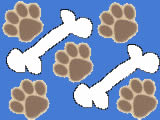Canine Physical Care
One simple but very important way to care for your puppy or dog is to watch for changes in his appearance or behavior that may indicate that he is sick. To do this, you need to become familiar with the signs of what is normal health for your pet. You should also be familiar with your dog’s usual behavior so you can easily detect signs of illness and injury. This will help you spot potential problems early so your veterinarian can begin treatment sooner.
Eyes – Eyes should be moist, clear and bright. The whites of the eyes should have no red or yellow discoloration. If there is any inflammation, discoloration, tearing, constant blinking, cloudiness, heavy discharge, or other abnormal conditions, take your puppy or dog to the veterinarian immediately. A slight buildup of mucus in the corners of the eyes is not abnormal. This discharge can easily be cleaned away with a cotton ball moistened with warm water. Do not let your dog hang its head out of the car window or ride in the back of trucks. The dirt particles can cause eye infections. Long hair in the dog’s face can also cause eye problems.
Ears – Ears should be clean and free of discharge and odor. Check the ears at least once a week, or more often for dogs who are more prone to ear problems (such as long-haired dogs or those with long, droopy ears). Trim away excess hair, which might prevent air from getting into the ears. If your dog is scratching its ears or shaking it’s head a lot, it may be a sign of a yeast infection, bacterial infection, or ear mites. If the ear canal is red, inflamed, has a foul odor, or is sensitive to your touch, consult your veterinarian. Dogs with ear mites may have an ear discharge with increased wax and a dried blood or coffee ground appearance. Your vet will have to check the discharge under a microscope to identify an ear mite infection. Prevent ear problems by keeping ears clean and dry. Check with your vet and ask him/her to recommend a cleaning solution and have him/her show you how to clean your dog’s ears properly.
Mouth – The dog should have pink, healthy gums with no redness or bleeding when you touch the gums. The lips should be free of sores or growths. Teeth should be free of yellow or brown tartar buildup along the gum line and the dog should not have bad breath. Check for discolored, fractured or missing teeth. Any bumps or masses within the mouth should be checked by your veterinarian. Brush your dog’s teeth several times a week, at least, with a soft-bristled nylon toothbrush and a plaque-retardant, tartar-control toothpaste. Feed hard kibble dog food or biscuits at least once a day. The friction from chewing the hard food helps clean the teeth. Hard nylon or rawhide bones help remove plaque. Give your puppy or dog a hard chew toy at least once a week. Good oral hygiene started early and continued on a regular basis will prevent bad breath, tooth loss and gum disease.
Nose – Normal dogs may have hot, cold, dry or wet noses. If your dog has chronic sneezing fits, bloody or pus-like discharge from one or both nostrils, check with your veterinarian. It could be allergies, a foreign object in the nose or a bacterial, viral or fungal infection. Unlike people, a dog with a bloody nose is always cause to see the veterinarian.
Body and Coat – The body should be free of tumors, lumps, fleas and ticks. Check by running your hands over the dog’s coat. A normal coat is thick and shiny, without greasiness, dandruff or bare spots. Check for wounds, tumors, hair loss, dander, biting, scratching, bite marks, evidence of parasites, stickers and foreign objects.
Legs and Feet – Legs should be checked for swollen joints, lumps, or cuts. Inspect feet between the toes for excess hair or objects lodged there. Check for broken or cracked nails. Nails that are too long will grow full circle back into the toe and cause it to bend and be sore.
Anus – The anus should be free of swelling and intestinal parasites. For example, tapeworms are visible around the anus and appear as “rice-like” looking worms in the stool. Dogs will often scoot their behinds along the ground in an attempt to relieve swollen anal glands. If you notice any of these symptoms, see your veterinarian.






